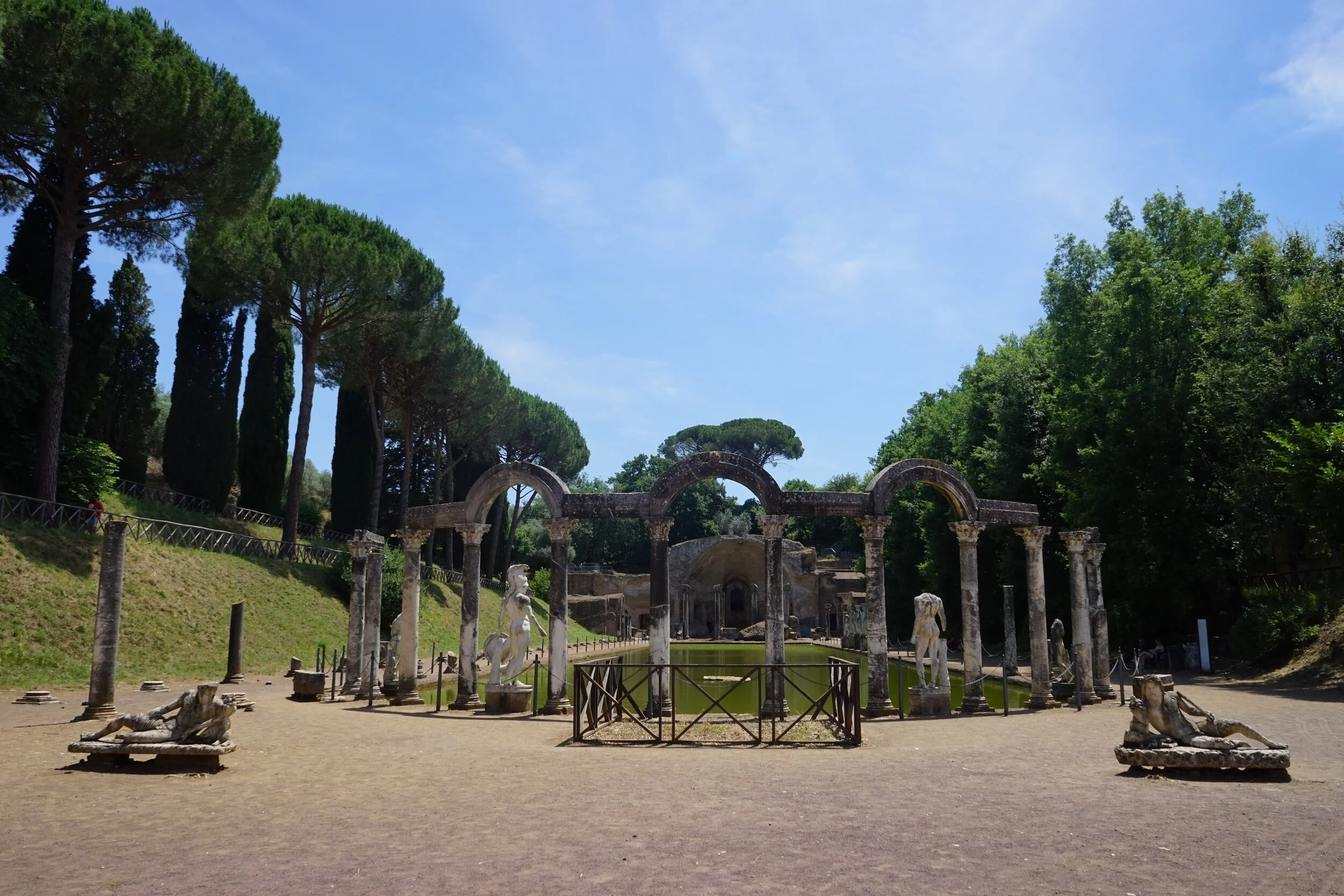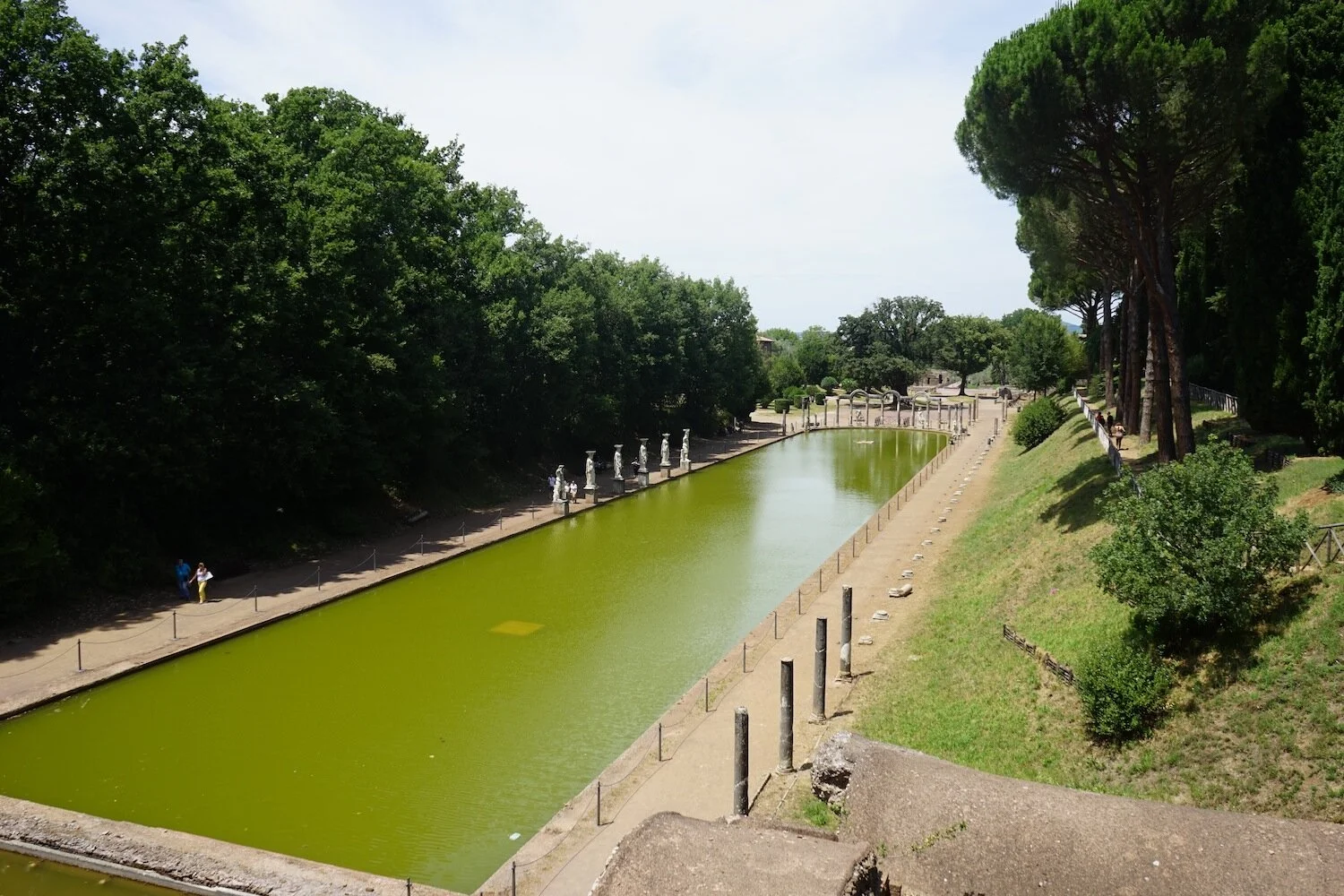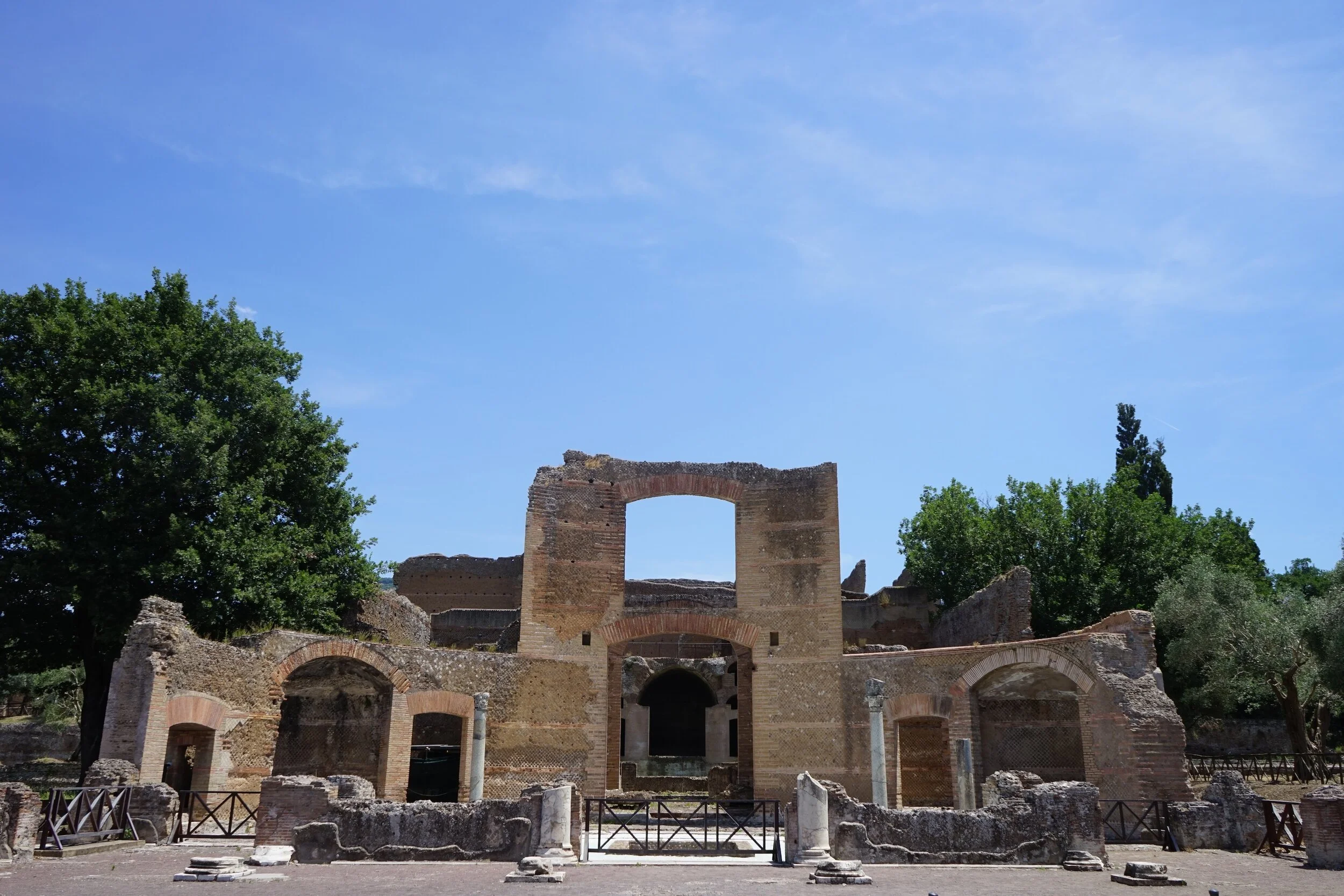Hadrian's Villa
an essay in duo
Dedicated to Eleanor Clark and Marguerite Yourcenar.
On a quiet spring morning lying under a tree on a hill of Tivoli, surrounded by the ruins of an ancient villa, I imagine a man with a green heart. Like the aristocratic builders of Nietzsche’s Genoa, a man who knew distant lands, the sea, adventure, wanderlust, long journeys. A man with a nostalgic soul. I imagine his joy and fantasy and aspiration in building a world where he surrounded himself only with those things that belonged to his spirit, with things in which he saw his reflection and his affinity (1). I imagine his nostalgia and his agony in anticipating that the time of his culture was running out, in feeling the big change that was coming, the turning of the wheels of history for one of the largest human civilizations – the Roman Empire.
Throughout his lengthy journeys, travelling all around the Empire and visiting almost every province, the emperor Hadrian cherished Greece and Egypt as some of his favourite destinations. Collecting bits and pieces of their cultural heritage he planted these seeds into his architectural ideas at the villa just outside of Rome. What was born from it was a kind of landscape of symbolism, a tribute to his travels and imagination, full of references to existent and nonexistent places, places from the visible world of physical reality and the invisible world of his imagination. Constructed between 118 and 134 C.E., this villa became Hadrian’s rural seat, his residence of choice, and a kind of retreat from the cares of Rome.
There is in fact a center (2), if you can call it that, and privileged place of retreat, in the sprawling labyrinth of the villa. Like the middle of an actual maze, it is a place that you come upon suddenly, unexpectedly, after wanderings through innumerable turnings and shifts of orientation, and what’s there at the center is a kind of secret garden, with no obvious exit, though you know there is probably more than one. Dubbed the Maritime Theater by modern archeologists, it is a tiny, elaborate palace (or temple?) on a perfectly round island, surrounded by concentric circles of moat, Ionic colonnade, and wall, the latter forming the outer celestial sphere of this microcosmic world.(3) Oddly reminiscent of Hadrian’s other great architectural project, the Pantheon, with its sphere punctuated by a central axis (in the case of the Maritime Theater, the axis is that of the entrance hall), it is a place of “miniature gigantism,” and the reduced scale of this monumental construction becomes all the more powerful in its juxtaposition to the vast labyrinthine villa that surrounds it, and of which it is both center and metaphor. Indeed, the fantastic, or phantasmatic, character of the architectural jumble that extends outward in all directions from this inner sphere is still further emphasized by the fact that you can see none of it from this spot, but instead must project it imaginatively, from the memory of the paths you travelled, through shifting architectural spaces and viewpoints, to arrive at this idyllic place, a locus amoenus marked for contemplation by the graceful continuity of its encircling Ionic order.
With its mosaics, frescoes, sculptures of Greek gods and goddesses, fauns, as well as Egyptian deities, telamones, pilasters with Dionysiac motifs and Corinthian columns, Hadrian’s Villa became a place where past and present connected – Hadrian’s time and an echo of the ancient Greek and Egyptian worlds in it. Perhaps it gave him a sensation of holding the same thread, the same thin thread of humanistic values, reaching from the times of antiquity into his present, lifting his spirit from the loneliness and nostalgia of being the only one left, and connecting him to lives of people who came long before his time. This time that connects past and present in a non-linear way becomes a kind of time that smashes the chronological continuum of centuries and reconnects moments of the past with the present, as if restoring the ruins left behind by history. It is these kinds of places, like Hadrian’s villa, that remind us that time can bend and connect us back to the cycles of things in nature and culture, where everything is dying and being resurrected infinitely. As if a kind of a thread is going across centuries - a whisper of human ideals that still speak to us today, reminding us that we are part of this thread.
In some corners of the villa, the simultaneous expansion and collapsing of time is especially resonant. The so-called Hall of Doric Pillars evokes the festive, even decadent, former life of the villa as almost nowhere else. The crumbling luxury of its still-standing colonnade extends its two arms outward as if inviting the viewer to complete the courtyard’s architecture and re-experience, in memory, the life of the court. You feel time’s presence here, and especially the dilated life of objects and buildings: the delicacy and even frivolity of the carved ornament stands there in shifting sun and shadow, seemingly indifferent to the passing of time, centuries and millennia after the artists who labored over these beautiful details have lived their lives and died. (4) And yet these stones too have their lifespan, expansive as it may be, manifest in the interplay between architectural decay and natural reclamation. At the same time, there’s something of the presentness that characterizes all art, when one is actually experiencing it (“presentness is grace,” as Michael Fried might say), that speaks perhaps most eloquently in the smallest details. These are details that might normally have remained unnoticed when the hall was in its prime but that, when seen, speak with the same aesthetic directness to a viewer standing in the villa-as-ruin today as they might have to a reveler from Hadrian’s time who chanced to glimpse them in passing and briefly contemplate them by torchlight. This is one of the places in the villa where such details are still present, and you feel that the architecture here is simultaneously absorbed into the temporal cycles of nature and speaking in its own formal and expressive language, outside of time, as it were.
The two forces - nature and culture - are complementary in this space, in a constant dialogue with each other. The cycles of seasons, the reflective qualities and movement of water enlivening the static forms of architecture and sculptures around the villa. These days culture and nature are even more immersed into one another. Trees grow through the walls and openings of ancient buildings, claiming back the space. Somehow opposing the tendency in most places in our world, where our civilization claims more and more space from nature. This place has become like a temple for meditative reflection, human continuity and memory reflected in time, both personal and cultural. A memory of ancient cultures with their values and aspirations, an expression of Hadrian’s travels, and more metaphorically and subtly his personal culture, dreams and wishes for a kind of life on Earth.
One of Piranesi’s etchings from the 1776 Vedute di Roma (Views of Rome) (5) series shows the interior of the Canopus (as it is called today), an architectural view whose diagonal impetus into pictorial depth is complemented by another movement in counterpoint, the vertical growth of plants in the upper part of the image. The drama of the architecture’s depth axis – its opening up of an evocative and cavernous space – is emphasized by human figures at different distances (one pair near the foreground echoes another pair beyond, half-dissolving in the luminous, atmospheric depth). However, this drama is also tempered by the deliberate, imperceptible slowness of the vegetal movement above. The trees growing upward towards the light, and the vines and tendrils hanging down into the architectural hollow below, together form a consistent vertical axis in dialogue with the orthogonal axis of the architecture. More importantly, however, they also convey a different kind of movement, and thus a different sense of time, one more deliberate and dilated, persistent yet imperceptible. Much of the grandeur of Piranesi’s etching arises from these juxtaposed alternatives of movement and time, yielding a dialectic between architecture and nature. Just as the architecture produces a dramatic intervention into the natural landscape – the sudden irruption, with self-conscious theatricality, of an artificial cavern – so too does the natural realm, for its part, gradually reincorporate the architectural intruder into its own cyclical growth and decay processes, re-appropriating the cavern as one of its own.
As it is with much of ancient history, a lot is based on guesswork. Places where people were born, how they lived day after day, what made them happy, sad, worried, interested. It’s all quite a mystery to us today. What they did leave for our imagination are a few facts about their political and military endeavors, as well as works of art and architecture. To really imagine Hadrian, what kind of man he really was, would obviously require from us to look at the whole package - not only his humanistic aspirations and architectural ideals, but also to look at all those other things that make up an emperor: wishes for superiority, power, dominance, the struggle with accepting other points of view. We are all multitudes. Architecture can express this too, when looked at from different angles and imagined from all kinds of standpoints. Walking around this ancient place today we might see the wall Hadrian built to separate from the rest of the world, we might see his attempt to build his own world and to be left in peace, we might even see his trust in the cyclical nature of life that will bring it all back again some day in the future, like a thousands year old thread disappearing and appearing over and over again. After all, being a visitor here after so many centuries we bring our own meaning to this place. It becomes about the personal symbolism we give to it, about what the place becomes in our own eyes, what kind of shelter it offers us, what we seek to see in the past, what we bring with us into our present. The landscape of Hadrian’s Villa today has a strong symbolic and evocative power. Once we step onto its ground, the doors of history open, and it becomes up to us what kind of feelings, dreams, ideas, memories, and hopes it will awaken in us, what from that history we will invite into our present.
One of the strangest sights in the villa, often the first thing seen upon entering and the last upon leaving, is perhaps the one that stays with you the longest: the solitary wall, seeming to stretch out towards infinity – and certainly towards the horizon – known as the Pecile. (6) Whatever its original function (and it may have had more than one, including that of a picture gallery, like its namesake and original in Athens), today it seems to do nothing so much as ask us to look, walk, and explore – or rather, it is a visual emblem of our movements and sight-lines in stubborn, exposed brick. And it points towards that horizon, where Rome lies, at the limit of vision (just barely visible on a clear day). Like Rome itself, the villa is a vast extension in the dimension of time, an extension far vaster than that of its spatial sprawling. And like the Eternal City, that time dimension is not only constituted by the mere existence of the place across millennia, or even by its intimate dialogue with the cycles of nature, but primarily by its echo and memory of the cycles of human life. Rome is all the people who have lived, worked, and loved there – and those who, live, work, and love there still. And the villa, though now solitary and abandoned, in its own way is also, like Rome, an invitation to participate in the continuity of human life, to recognize oneself as a part of the diversity of human lives that have shared memories and experiences in these very places. The welcoming – and valedictory – gesture of the Pecile, pointing towards the living city of Rome on the horizon, is no small part of this invitation.
_________
1 Cf. Nietzsche, The Gay Science, bk. IV, sect. 291.
2 This section and some others below are inspired by the tone and character of Eleanor Clark’s great essay on Hadrian’s Villa in Rome and a Villa (1952).
3 Photo of the Maritime Theatre by Tango 7174 /creative commons license/ http://creativecommons.org/licenses/by-sa/3.0/deed.en
4 Photo of the detail of the Hall of Doric Pillars by Camelia.boban /creative commons license/
5 Etching print "Veduti di Roma" by Giovanni Battista Piranesi
6 Photo of the view of Pecile from the Room of Philosophers by Zanner
/creative commons license/
"The peace will come again between two periods of war: the words of liberty, humanity, justice will find here and there the meaning we had tried to give them. Our books won't perish all; our ruined statues will be repaired; some people will think, work and feel like us; I dare to count on these continuators placed at irregular intervals along the centuries, on this intermittent immortality." (from "Hadrian's Memories", a magnificent book by Marguerite Yourcenar)
Words: Geoff Lehman, Sabina Enéa Téari
Photography: Egor Sviridenko, Sabina Enéa Téari

















